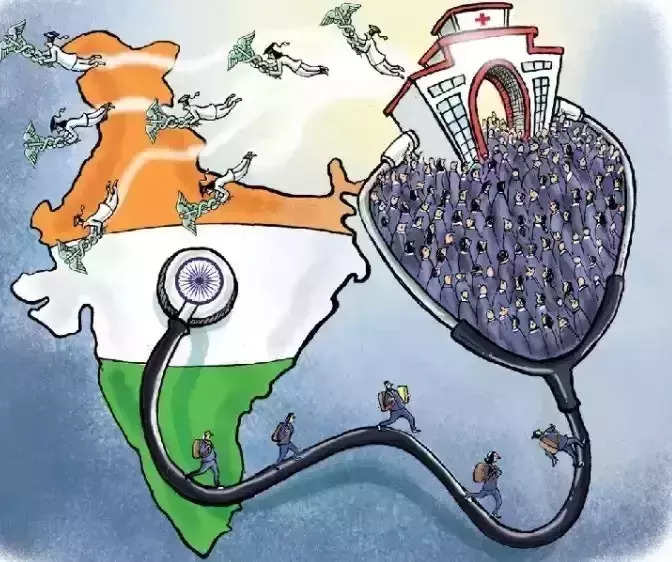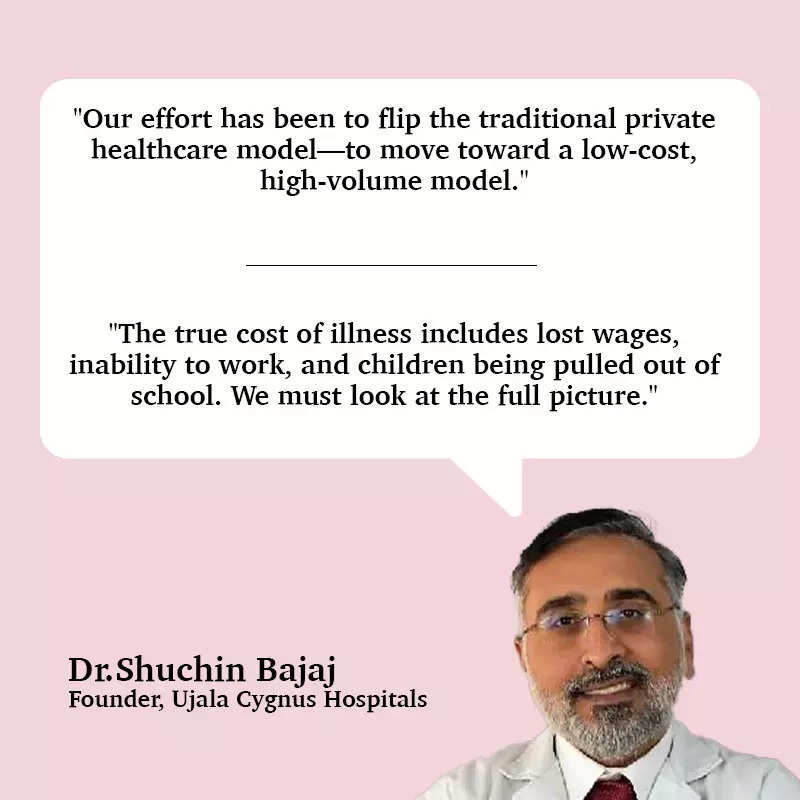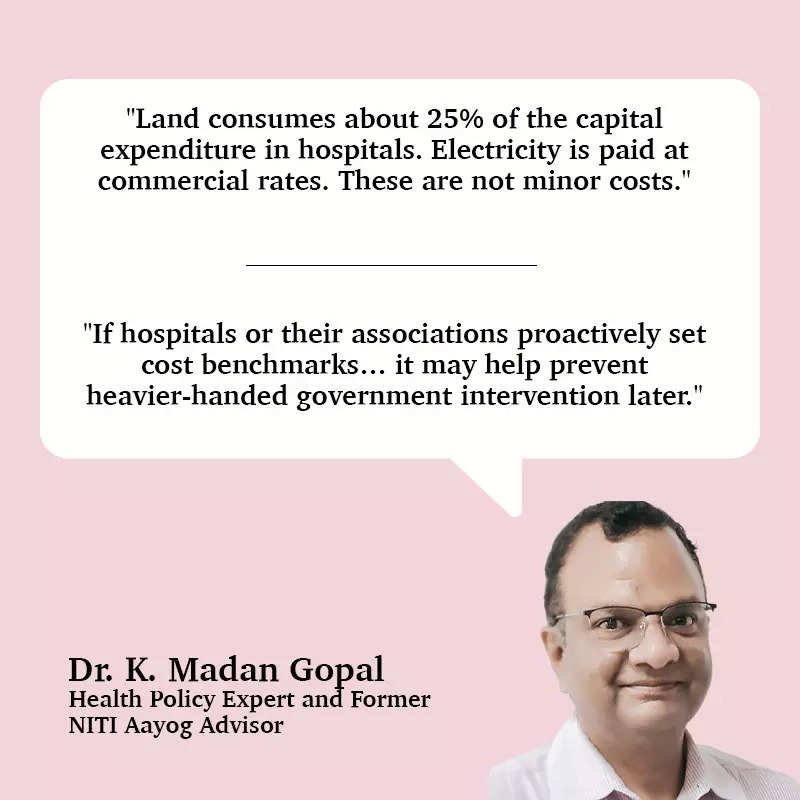
New Delhi: India’s healthcare problem isn’t just about rising prices—it’s about crafting a system that balances sustainability, entry, and fairness. As the nation grapples with rising healthcare calls for, systemic inefficiencies, and budgetary constraints, distinguished stakeholders are calling for daring, multi-pronged reforms. As India’s public well being schemes develop and personal gamers dig deeper whereas widening their attain, the want for stronger regulation, modern insurance coverage fashions, incentivized investments in underserved areas, and a decisive shift from illness to wellness has by no means been extra pressing.Healthcare leaders are sounding the alarm, articulating that one-measurement-matches-all options for healthcare sector gained’t lower it anymore. What’s wanted are multi-layered reforms that align incentives with outcomes and match funding with actual wants. At a current excessive-degree webinar organized by ETHealthworld on the matter: Is the Surge in Non-public Hospitals Making India’s Healthcare Unaffordable?, main voices from the trade acknowledged that it’s not a single-threaded problem. It’s embedded in a posh internet of legacy underinvestment, fragmented governance, skewed incentives, and rising shopper expectations. However indicators of progress are seen—from new-age care supply fashions to payers and suppliers becoming a member of forces to construct frameworks round worth and transparency. What emerges is a hopeful but pressing name: India doesn’t simply want extra healthcare—it wants smarter healthcare.The dialogue started by highlighting the obvious disparity between authorities-mandated charges below PM-JAY and what personal hospitals in metros cost for the identical procedures. As an example, dialysis below PM-JAY is priced at ₹1,500, whereas personal hospitals cost ₹2,500–₹5,000. Equally, coronary angioplasty is reimbursed at ₹40,600 below the scheme however can price wherever between ₹66,000 to ₹2,15,000 in personal services. This chasm poses a critical problem to center-revenue households throughout the nation. The obvious hole leaves out tens of millions from the grand imaginative and prescient of constructing healthcare reasonably priced to all.

Answering this, C.Okay. Mishra, IAS, Former Union Secretary, MoHFW and Former Union Secretary for Setting, Forests and Local weather Change, Authorities of India, stated, “It is a query many grapple with, typically attempting to reach at their very own solutions. The fact is that healthcare provisioning in the personal sector in India is sort of costly, and the providers supplied by giant hospitals are sometimes out of attain for the widespread man. That stated, it isn’t truthful to check schemes like PM-JAY with personal healthcare providers. Apparently, many personal hospitals admit they use their common paying sufferers to cross-subsidize remedies below PM-JAY or CGHS.”
That’s when most main hospitals in cities have opted out of the scheme citing varied causes like the mismatch in the charges and lengthy delays in getting reimbursed.
In addition to, Mishra highlighted systemic gaps—significantly the underinvestment in public well being infrastructure—as a driving power behind the growing dependence on costlier personal healthcare. He candidly stated, “The funding the authorities was meant to make in public healthcare has not saved tempo with precise wants, forcing folks to show to costlier personal services. Common insurance coverage remains to be a distant objective.” In his view, the want is to suitably ramp up the healthcare finances.
The Financing Shift and Hospital Market Segmentation
Providing a macroeconomic perspective, Dr. Prem Pavoor, Senior Companion at international funding group Eight Roads Ventures, stated, “Round 70 per cent of hospital capex in India has sometimes come from the personal sector, whereas the authorities has contributed about 30%. Not too long ago, we’re seeing a notable shift. The federal government seems to be transferring towards a mannequin much like that of the United States, taking part in the function of a payer via schemes like Ayushman Bharat somewhat than being each a supplier and a payer.”
He identified that regardless of rising hospital expenses, Ayushman Bharat has performed a transformative function in increasing entry. “Healthcare stands out as the solely sector in India the place personal fairness investments have doubled publish-COVID. A terrific instance is the Ujala Cygnus chain co-based by Dr. Suchin Bajaj, which has successfully leveraged Ayushman Bharat to ship reasonably priced healthcare.”
Noting that the hospital ecosystem is maturing into distinct fashions, Dr. Pavoor stated, “What we’re seeing now’s a transparent segmentation… In parallel, we’re witnessing the emergence of recent gamers in smaller cities—typically developed from nursing properties—geared in the direction of delivering mass, reasonably priced care… Over the subsequent three to 4 years, I imagine we’ll see this ecosystem mature additional.”
A New Mannequin: Low-Value, Excessive-Quantity Care
Dr. Shuchin Bajaj, Founder, Ujala Cygnus Hospitals, who has constructed his healthcare philosophy round accessibility with variety of reasonably priced care hospitals in smaller cities, stated, “Our effort has been to flip the conventional personal healthcare mannequin on its head. We now have been working to reverse that—to maneuver towards a low-price, excessive-quantity mannequin. Schemes like PM-JAY positively assist in that course.”
Bajaj, who can be a vocal critic of the fee-for-service mannequin, stated, “It essentially misaligns incentives between docs and sufferers. If a affected person has a coronary heart assault and involves me, my incentive below fee-for-service is to deal with it. However the affected person’s actual incentive is to not have that coronary heart assault in the first place.”
Stressing that the true price of sickness extends far past hospital payments, Dr. Bajaj profoundly stated, “The true price contains misplaced wages, the incapability to work, kids being pulled out of college to assist the household… We have to take a look at the full image—from prevention to infrastructure to entry and lengthy-time period societal prices.”
Infrastructure Bottlenecks and Rising Enter Prices
Dr. Okay Madan Gopal, Well being Coverage Knowledgeable and Former Advisor, NITI Aayog, defined that as incomes rise, so do healthcare prices. “However the tempo at which each are rising isn’t at all times in sync… We at present want round 42 lakh hospital beds to cater to India’s inpatient care wants. In actuality, we’ve got about 19 lakh beds,” he added.
“This shortfall has pushed personal sector growth, particularly in tier 2 and tier 3 cities. However that comes with challenges. Non-public suppliers should spend money on superior expertise… bringing in new expertise considerably raises the price of care. The price of buying a affected person is roughly 30%—and that price is handed on to the affected person,” Dr. Gopal stated.
Highlighting different vital price drivers, together with salaries, accreditation requirements, and land prices, he stated, “Land consumes about 25% of the capital expenditure… hospitals pay industrial charges for electrical energy, which is a significant expense. Though ‘trade standing’ was granted to healthcare in the 2017 Price range Speech, the advantages are nonetheless pending full implementation.”
Dr. MadanGopal additionally emphasised the want for value transparency and self-regulation. “One recurring suggestion is the want for self-regulation. If hospitals or their associations proactively set price benchmarks… it could assist forestall heavier-handed authorities intervention later.”
The place Do We Go From Right here?
Whereas panelists have been questioned on how India’s healthcare ecosystem is present process dramatic transformation—enterprise capital is flowing, hospitals are increasing into smaller cities, and digital consciousness is empowering sufferers—one urgent query looms giant: Is healthcare nonetheless reasonably priced for the common Indian?
On one hand, there’s a push for accessibility, however affordability stays a critical concern—a difficulty echoed throughout the sector. With a surge in personal sector investments, particularly in smaller cities, the query arises—how will these initiatives ship a return on funding, significantly when reimbursement challenges persist below public medical insurance schemes like Ayushman Bharat?
Commenting on this and noting a definite shift in affected person conduct, Dr. Pavoor stated, “The smartphone has considerably bridged the data asymmetry between sufferers and docs. Immediately, sufferers arrive for consultations already having researched their circumstances on-line. They search second opinions, evaluate healthcare suppliers, and make knowledgeable decisions based mostly on value and perceived high quality.”
This newfound consciousness, coupled with rising insurance coverage protection, has led to a wave of healthcare investments—each giant and small. However Dr. Pavoor added a word of warning: “With the quantity of capital that’s are available in, competitors is intensifying. Each supplier is now concentrating on the identical affected person, which is able to naturally convey pricing pressures.”
Dr. Pavoor was of the view that whereas the charges for remedy is spiralling in the cities, over just a few years there will likely be a correction since each hospital will vie for the identical affected person and the closing alternative will likely be with the affected person.
Center-Class Squeeze: A New Vulnerability
We’re now not simply speaking about affordability challenges amongst the low-revenue inhabitants—healthcare has turn into unaffordable even for these in the center and higher-center revenue brackets. When panelists have been requested whether or not the Scientific Institutions Act, meant to convey transparency to pricing, had made any actual influence:
Taking a really essential stance, C.Okay. Mishra stated, “Only a few states have adopted the Act, and people who did have largely performed nothing to implement or implement it. Neglect charge boards—in lots of circumstances, sufferers don’t even know the estimated price of their remedy till they’re discharged. That degree of opacity is unacceptable.”
Mishra, identified to be an avid follower of traits in the healthcare trade due to this fact warned, “If the sector continues to stay non-clear, it’ll inevitably invite regulatory intervention. At that time, hospitals could have no ethical floor to withstand.”
However Mishra additionally referred to as out a deeper systemic flaw—India’s over-reliance on tertiary care. “We’re constructing a sick-care system—reactive and remedy-oriented. So long as this imbalance persists, the price of remedy is unlikely to return down.”
The Rural Dilemma: Value, High quality, and Capital
Dr. Shuchin Bajaj didn’t sugar coat the challenges both. He famous, “Attracting excessive-high quality docs, nurses, and bringing in the greatest expertise into smaller cities isn’t any straightforward activity. All hospitals, no matter location, have to be NABH-accredited and supply scientific outcomes which are at par—if not higher—than these in greater cities.”
Exposing a typical fable, he stated, “We now have even seen insurance policies the place authorities schemes pay greater reimbursement charges to huge-metropolis hospitals than to these in small cities. That’s based mostly on a fable—that it’s cheaper to run a hospital in a smaller city. Let me say this clearly: it’s not.”
Calling for sturdy authorities assist to develop healthcare attain, Dr. Bajaj stated, “If authorities insurance policies are seen to assist and publicly reward these excessive-performing establishments—even when they generally err on the facet of overpaying them—that’s high-quality. These are the sorts of ‘errors’ we are able to reside with.”
The Shift from Supplier to Payer: A Double-Edged Sword
One other vital concern on transformation of CGHS (Central Authorities Well being Scheme) right into a referral mechanism that channels sufferers to non-public hospitals, typically with restricted oversight, was requested to panelists.
Dr. Bajaj identified that the root causes of healthcare points weren’t being addressed and as an alternative, the system was more and more transferring towards a sick-care mannequin. He talked about that with a fee-for-service construction in place and the authorities transitioning from being a supplier to a payer, such points have been more likely to persist.
Highlighting a harmful development, he stated, “Common practitioners (GPs)—the spine of preventive care—are quick turning into a vanishing breed. Most MBBS graduates at this time don’t need to observe as GPs… they goal to turn into tremendous specialists, typically drawn by the promise of taking part in with the newest expertise and incomes extra.”
CGHS: A Misplaced Litmus Take a look at?
“First and foremost, this overemphasis on CGHS is a bit misplaced,” stated Mishra. “We’re speaking a couple of comparatively small inhabitants of central authorities workers—they can’t be the benchmark for assessing whether or not India is progressing in the well being sector.”
Whereas CGHS payouts have elevated dramatically, Mishra attributed this to a spike in personal hospital referrals and the clearing of longstanding dues—underscoring systemic mistrust in public hospitals. “Neither sufferers nor docs believe in public services, and that’s the actual tragedy,” he famous.
His daring suggestion? Rethink India’s 4-tiered healthcare mannequin and experiment with GP-led fashions the place normal practitioners are accountable for particular populations—methods confirmed efficient globally however but to be adopted meaningfully in India.
Dr. MadanGopal agrees that CGHS at this time is trapped in a legacy mannequin, unwell-outfitted to serve its ageing and comorbid inhabitants. The actual problem, he suggests, is structural: “Many CGHS beneficiaries have personal insurance coverage however nonetheless don’t obtain the high quality or timeliness they anticipate. That speaks volumes about inefficiencies.”
He recollects an initiative to combine CGHS with Ayushman Bharat (PM-JAY) for price rationalization—a proposal that did not take off. His prescription is straightforward however impactful: “Construct annual well being test-ups into CGHS—for workers and their households. Early detection can scale back ballooning remedy prices.”
Public vs Non-public: Are We Discovering the Proper Steadiness?
On whether or not India has diminished the monetary burden on its residents, Dr. MadanGopal factors to encouraging indicators: “Out-of-pocket expenditure has dropped to below 40 per cent, and that’s a milestone. However well being inflation is rising, and so is family expenditure on care.”
He credit initiatives like free diagnostics, Jan Aushadhi, and the large investments below the PM-Ayushman Bharat Well being Infrastructure Mission for serving to to construct a extra resilient public system. Nonetheless, he cautions, “We’re in a race towards scale. Infrastructure is increasing, however so is demand.”
In the meantime, Dr. Pavoor believes the healthcare funding panorama is present process a quiet revolution. “We’re lastly at a stage the place the conversations have matured—from fragmented main care fashions to built-in, end result-oriented care ecosystems,” he says.
“Earlier than Ayushman Bharat, we weren’t even speaking about common well being protection. Now, we’re transferring towards worth-based mostly care and closed-loop methods,” he provides, referencing international fashions like Kaiser Permanente and neighborhood-centric care pilots resembling Iora Well being in the US.
He warns of the dangers of revenue-first fashions, stating, “Affected person outcomes in PE-funded US hospitals have been worrying,” however stays optimistic about the Indian trajectory. Area of interest investments in outpatient care, built-in platforms, and tech-led fashions are gaining traction.
“Even influence buyers need sustainability,” he provides. “And in India, that path could lie in properly-designed, expertise-enabled ecosystems.”
The panelists made it clear: if India is to emerge as a very inclusive healthcare energy, accessibility alone gained’t be sufficient. Affordability have to be protected, transparency have to be enforced, and investments should assist not simply enterprise objectives however healthcare outcomes.
Whereas C.Okay. Mishra reiterated, “What India really wants is healthcare, not only a well being enterprise. That distinction should stay clear,” Dr. Bajaj added, “If the intent is actual, the influence will comply with.”
The consensus amongst healthcare leaders is evident: India’s healthcare future hinges on systemic integration, preventive care, and belief-constructing in public methods. Whereas initiatives like Ayushman Bharat have laid the basis, it’s the subsequent wave—rooted in worth-based mostly, GP-led, tech-built-in fashions—that holds the promise of actual transformation. It’s time to cease patching outdated frameworks—and begin constructing healthcare for India of 2047.
Source link
#Indias #Healthcare #Inequity #Experts #Expose #Cracks #Prices #Call #Coherence #HealthWorld








